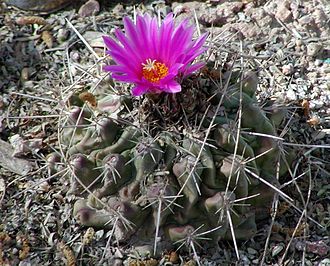Thelocactus

Thelocactus is a genus of flowering plants in the cactus family Cactaceae. Members of the genus are native to the arid lands of Central and Northern Mexico.
Thelocactus species are globe-shaped, short and cylindrical. They are small cacti, although there are one or two species which, while only about 15 cm high, can be 25 cm in diameter; for example, T. nidulans. Thelocactus species are generally solitary, but some varieties will cluster in groups.
The ribs on Thelocactus species are very clearly marked and are sometimes twisted in a spiral. There can be from 8 to 20 ribs, which are rather low and normally marked with raised, angular or hexagonal tubercles. These tubercles can sometimes be difficult to distinguish. Areoles sit in a furrow directly above where the spines grow and there can be up to twenty radial/radiating spines.
They are often needle-like, spread out and can be from 1.3 – 1.5 cm long. The central spines are mostly coarser, number up to six, stand vertically out from the plant and can be 2.5 – 7.5 cm long. Colours of all of the spines vary and include white, gray, golden-yellow and red-brown.
Flowers grow from the new areoles at the very top of the plant. They are funnel-shaped, have a diameter of 2.5 – 7.5 cm and their colours vary from white to shades of yellow, red or purple. They are diurnal. Fruits are small, globe-shaped and plain.
They are dehiscent through the large basal pore, green to brownish purple [to magenta], spherical to short cylindrical, 5 – 18 x 6 – 17 mm, not juicy, drying immediately after ripening, scaly, spineless, hairless and with floral remnant persistent.
